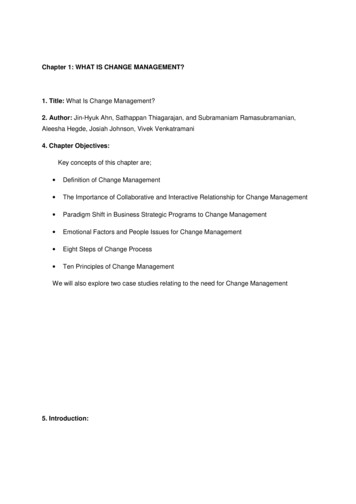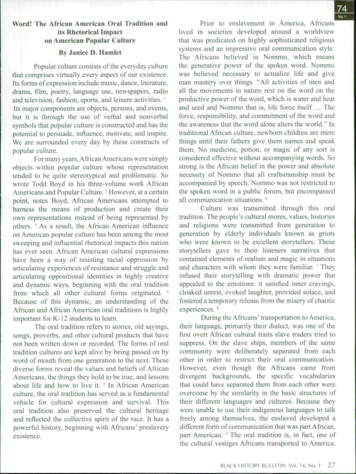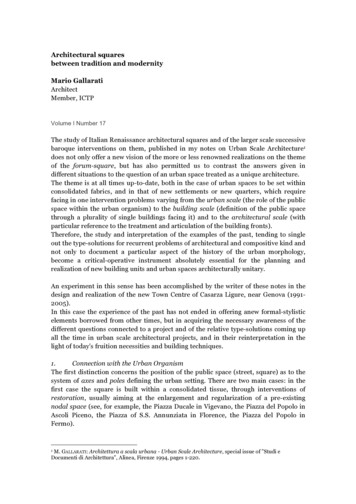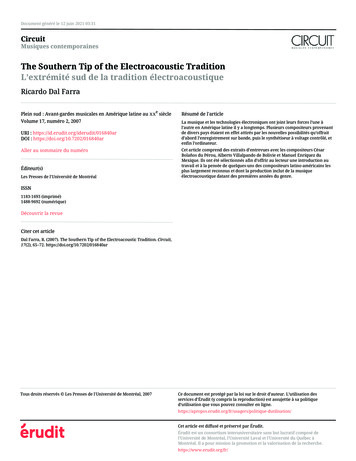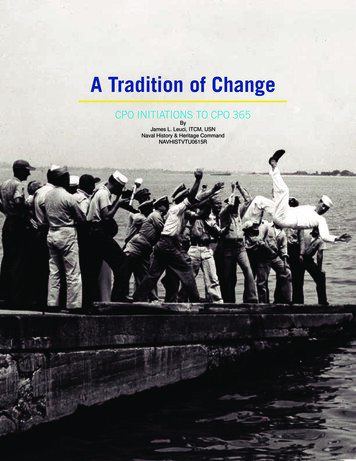
Transcription
A Tradition of ChangeCPO INITIATIONS TO CPO 365ByJames L. Leuci, ITCM, USNNaval History & Heritage CommandNAVHISTVTU0615R
2
Author’s NoteThe history of chief’s initiations has generally been passed down by word ofmouth. Many articles have been written based on those stories. This paper isan attempt to document, with facts, how chief petty officer initiations haveevolved since the end of the Second World War.Close to seventy-five chief petty officers were interviewed for this paper rangingfrom those who made chief during WWII to those who made it a couple yearsago. I’m thankful for their time and sharing their experiences. Without them, thispaper couldn’t have been written. Documents from official Navy publications,correspondence, and archives as well as the National Archives were also reliedupon for factual information. They were used to confirm and collaborate loreassociated with CPO initiations and in some cases, debunk it.The paper is not intended to condemn or condone initiation practices of the pastor present. It was not written to defend the changes and reforms that began whenMCPON Del Black issued the first CPO initiation guidance in 1968. However, itis clear that if CPO initiations had not been reformed in the 1980s and 1990s,allowing them to evolve to CPO 365, this paper would have been about a traditionthat became extinct a quarter century ago.CPO initiations are a tradition of change with one constant for all which is thebond we all share regardless of when we made Chief.James L. Leuci, ITCM, USN1 April 20153
IntroductionInitiation, Induction, transition, CPO 365-- there is just no denying the emotional reaction ofsome Chief Petty Officers (CPO) to changing any aspect of a Sailor’s traditional transitionto the CPO Mess. Often, these reactions arise from not fully understanding the reason andneed for the change. This document is the first ever definitive work detailing the uniquehistory of Sailors’ transition to CPO from 1893 to present. Master Chief Jim Leuci hasincorporated oral histories, official documents and imagery to bring a proper perspective tothis revered event. His work provides a perspective which makes it clear that the CPO Messhas not “lost” anything of real enduring value as a result of change to the transition process.Frankly, his work highlights the increased value that’s been added to a process to developfuture CPOs mentally and physically preparing them to join the Mess, while instilling a fiercelife-long camaraderie.Many changes occurred before and during my 27 active years in the Mess. What beganas a simple celebration of a Sailor becoming a CPO gravitated over the years to what oftenbecame a denigrating and excessive exercise to impress upon selectees the “value” ofhumility. It is still a strongly held belief, by some, that to build “tough” Sailors we mustsomehow,” break them down”, treat them poorly or be disrespectful in order to make them“humble.” However, most of the old initiations along with the accompanying excesses wereborn of two of the best traits still observed in good CPO Messes . . . a demonstrable senseof good humor and the ability to have fun. What began as a simple “wetting down” simplygrew from the natural desire of the Mess to outdo what was done the previous year.The fact that every Master Chief Petty Officer of the Navy (MCPON) from Del Black to MikeStevens felt it necessary to take a round turn of change on the process should not be loston any CPO. Throughout the years it was often heard, “the MCPON is trying to end CPOinitiations.” This document should put that falsehood to rest. The facts as laid out byMaster Chief Leuci clearly support that the MCPONs were trying to preserve the tradition.Every MCPON knew the CPO tradition of transition would have been forced to an untimelyend had they not made the necessary changes to the process they did. The end would havecome not because of change, but because of lack of change.Each year, the Navy invests hundreds of thousands of man-hours in the CPO transitionprocess. Accordingly, the Navy has every right to expect a well-defined and well-developedCPO as a result of such a massive investment. The CPO 365 process produces that welldefined and well-developed CPO not just in some Messes, but across the entire Navy4
Anyone who truly understands the CPO Mess knows that ending the process would be devastating tothe Navy. Many believe the most important thing the CPO transition process accomplishes is bringingthe CPO selectees into the Mess. It does do that very well, but the process also does something muchmore important. It is what we do at the same time each year, across the entire Navy, when we don“the hat” and stand shoulder-to-shoulder with our fellow CPOs. It is when, not uncommonly with atear in our eye, Chief Petty Officers recommit and rededicate themselves to the ideals of being a Chief.Those ideals, contained in the Chief’s Creed, are read at every pinning ceremony every year.Stop the CPO transition process? I think not. However, the evolution of the process was and willcontinue to be necessary so that we never lose it. Surely, without this process it could be arguedwe would not have the CPO Mess of today that’s held in the highest esteem by everyone inside andoutside our Navy.MCPON(SS/SW/AW) Jim Herdt USN(Ret)9th Master Chief Petty Officer of the Navy1998-20005
EForwardvery chief petty officer, active, reserve, and retired should read“A Tradition of Change-CPO Initiations to CPO 365” Study itand review it each year on 16 September when we renew ourcommitment to the tradition and heritage of the CPO mess worldwide.Reading “A Tradition of Change” brought back many good memories,a few bad, and tears to my eyes. I have always been very proud to bea member of the U.S. Navy Chief’s Mess—the finest group of menand women in the world. That pride continues to grow as I continueparticipate in what we now call CPO 365.Each of my fellow MCPONs and I have brought about necessarychanges in order to preserve a Navy tradition that has bonded our messfor over seventy years. These changes were implemented, not to inflateegos or to make change for the sake of change. Change was neededto preserve the tradition from extinction and to serve the Navy withstandards that better prepare chief petty officers for their role in today’sNavy. Change is an inevitable tradition; we must accept it smartly or getleft behind.“BZ” to MCPON Mike Stevens for commissioning Master Chief JimLeuci to research and document CPO initiation history for us and forfuture generations of chief petty officers. “Let the Buck Stop Here”MCPON Duane R. Bushey USN(Ret)7th Master Chief Petty Officer of the Navy1988-19926
Leuci Graphic from BuNAV Pressed Letters File 1890s National ArchivesCopies of receipts acknowledging the Appointment to Chief Petty Officer that were signed and mailed back to the Bureau of Navigation in Washington, DC. Nearly sixtyfirst class petty officers were appointed to new chief petty officer rates on 1 April, 1893.7
“SWIM CALL” BOOT CPO STYLEOn the day when Edwin G. Sandbergbecame a chief boatswain’s mate, one ofhis first thoughts was of the Pearl Harborcustom of throwing new chiefs into thenearest swimming pool.“No man is going to toss me into anypool,” he asserted. “Very well,”assured his CO, “Your wishes will berespected.”That little matter taken care of, Sandbergwas ready to go along with any other gaghis initiation might include. He fell intoline when a party appeared to escorthim to the ceremonies, and it just sohappened that this was in the generaldirection of the Pearl Naval Stationswimming pool.It was a happy group of marchers. Adrummer beat the cadence and the newchief fell gaily into step with master-atarms men, his buddies, and five WAVESwho joined the procession. Down topoolside the marchers came. Confidently,remembering his skipper’s assurance,Sandberg ventured near the water.The male members of the party laggedbehind. The next thing he knew, theWAVES had given him the heave ho andthe deep six.No man had tossed him in--but he wasall wet anyway.ALL HANDS September 1960Naval History and Heritage Command photograph81949 A new chief petty officer is thrown in a pool at Naval Reserve Training Center Chicopee, Mass. as part of his CPO inititation. The mainevent of early CPO initiations involved throwing new chiefs in a pool or over the side of a ship or submarine.
TABLE OF CONTENTS1IN THE BEGINING1893-1903102SWIM CALL AND SOME BEER1904-1945153CELEBRATING A PROMOTION1946-1953214CPO INITIATIONS EVOLVE1954-1959255THINGS START TO GET MESSY1960-1973356PUSHING THE ENVELOPE1974-1980547ANYTHING GOES1981-1990598FIX IT OR LOSE IT1991-1999689A NEW CENTURY2001-20088010 CPO 365 2009- 899
1IN THE BEGINING1893-190310
In the Beginning 1893-1903The history of Chief Petty Officer (CPO) initiations isprimarily an oral history that has been passed downfrom previous generations of chiefs. Very little hasbeen documented in writing either officially or unofficially.CPO initiations became prominent in the mid-1950s--60years after the chief petty officer classification had beenestablished in 1893. There is no exact date when CPOinitiations began. There is also no documented reason as towhy it took 60 years for initiations to begin.On March 3, 1893, U.S. Navy Circular #1 announced theestablishment of the chief petty officer classificationeffective April 1, 1893 1. Today, April 1, 1893 iscommemorated with celebrations, ceremonies, and khakiballs. However, the appointment of the first chief pettyofficers was not a major event of the day. The first chiefpetty officers of 1893 were not immediately elevated to ahigher enlisted status as a result of their appointments. Infact, there is no mention of the establishment of the CPOratings in the Secretary of the Navy’s annual reports to theU.S. Congress in 1893 or 1894 2.NATIONAL ARCHIVES IMAGE PHOTOGRAPHED BY LEUCIApril 1, 1893 Chief Petty Officer appointment letters were mailed to the shipsof the men promoted. Shown above is the receipt that was mailed back to theBureau of Navigation indicating the appointment letter for Chief Yeoman D.W.Crosby was received by USS Dolphin.On April 1, 1893 nine ratings were moved up into thechief petty officer classification. Eight of these ratings hadpreviously been first class ratings and the men were alreadywearing what had become the chief petty officer uniform.Three of the first class petty officer ratings had official titlesof Chief Boatswain’s Mate, Chief Quartermaster, and ChiefGunner’s Mate since 1885 3. They retained their titleswhen they became chief petty officers--nothing changed.The other ratings, Apothecary, Yeoman, Machinist, andBandmaster also retained the same titles they had used asfirst class petty officers. However, Master-at-Arms becameChief Master-at-Arms.Of those eight former first class ratings, seven had only tochange the rating badges on their uniforms. Chief Masterat-Arms did not have to make any changes since the ratingbadge they wore as first class petty officers became thestyle for the new chief petty officer rating badges.The only rating not previously a first class rating wasCarpenter’s Mate which had been a second class rating.Therefore, new Chief Carpenter’s Mates were required topurchase new uniforms and new rating badges.LIBRARY OF CONGRESS PHOTOGRAPH MODIFIED BY LEUCIChief Petty Officer 1897 ca. USS Nahant.After April 1, 1893, chief, first, and second class pettyofficers shared the same mess 4. For nearly ten years, chief11
LEUCI PHOTOGRAPHChief Petty Officer blue cap 1893-1897. The CPO cap device adopted in 1893 was the same device previously wornby first class petty officers from 1885-1893.petty officers continued to mess and berth with first andsecond class petty officers. In 1902, a change to 1900U.S. Navy Regulations formally established a separatemess for chief petty officers. All other enlisted men wereconsolidated into one general mess 5.The first Chief Petty Officer clubs on naval shoreinstallations were chartered after the turn of the century 6.Chief petty officers were still grouped with all other pettyofficers. For example, the appointment certificate givento chief petty officers was identical to the appointmentcertificate given to a seaman who was appointed to pettyofficer third class--it was titled a “petty officer appointment”certificate. Another example was that gold chevrons wereauthorized for all qualified petty officers--not just chiefs.The working uniform for all Sailors, including chiefs, wasdungarees. When Sailors wore dungarees the only visibledifference between chief petty officers and all others wasthe CPO cap.In 1903, General Order 134 modified the pay system forchief petty officers 7. Prior to 1903, Sailors were paid basedon their perceived value to the Navy and not according topetty officer class. The pay scales for chief petty officersranged from 70 a month for Chief Machinists to 50 forChief Boatswain’s Mates. However, a Machinist First ClassPetty Officer received 55 a month. Acting appointmentchief petty officers were paid the same amount as thoseserving under a permanent appointment.General Order 134 provided that all chief petty officerswho received permanent appointments, after July 1,121903, would receive 70 a month. Chiefs with actingappointments or permanent appointments issued priorto July 1, 1903 would continue to receive the lower pay,based on their specialty, until they qualified or re-qualifiedfor permanent appointments. The effect of General Order134 was that chief petty officers finally became the highestpaid enlisted men in the Navy.
NAVAL HISTORY AND HERITAGE COMMAND PHOTOGRAPH1903 USS Wisconsin Battleship #9 Chief Petty Officers. All chiefs with permanent appointments were required to be re-certified in 1903 to qualify for higher pay of 70 per month. Prior to 1903, pay was based on rating specialty and varied between CPO ratings. After 1903, all CPOs with permanent appointments received thesame pay regardless of rating.NAVAL HISTORY AND HERITAGE COMMAND ARTIFACT PHOTOGRAPHED BY LEUCIPetty Officer Appointment Certificate for Chief Gunner’s Mate John Murname dated August 20, 1903. Chief petty officers with permanent appointmentswere required to be recertified in 1903 in order to draw 70 in pay each month. Those who didn’t recertify continued to draw their pay at a lower rate.13
CHIEF PETTY OFFICER RATING BADGESAND CAP DEVICES1893-1897Chief Petty Officer cap device authorized 18931897 for wear on blue caps. The same device wasauthorized for wear by first class petty officers from1886-1893.Chief Petty Officer rating badge style adoptedin 1894.Chief Petty Officer rating badge style worn during1893-1894. The same style rating badge wasworn by Master-at-Arms from 1886-1893 .14Chief Petty Officer cap deviceauthorized in 1897. The device wasonly worn on blue caps until 1913.
SWIM CALL AND SOME BEER1904-1945215
NAVAL HISTORY AND HERITAGE COMMAND PHOTOGRAPH colorized by ITCM LeuciUSS Oregon Chief Petty Officers ca 1902-1905.When World War I ended most, if not all, of theoriginal 1893 chief petty officers had left or retiredfrom the Navy. The new generation of chiefs hadno memories of co-existing with subordinate petty officers.The chief petty officer mess and quarters were firmlyestablished at sea and ashore. Chief petty officers werethe highest paid enlisted men in the Navy. The status ofchief petty officers had also been elevated. CPOs enjoyedprivileges such as open-gangway liberty, not being requiredto stand personnel inspections prior to going on liberty,and had better accommodations while traveling on officialbusiness 8. CPOs also had better living quarters and betterfood than the rest of the enlisted crew.Chief petty officers’ status continued to improve during theyears between world wars. In 1929, chief aviation pilotswere authorized to wear the same aviation summer khakiworking uniform as naval aviator officers 9. In 1930, chiefpetty officers were required to wear rating badges with theeagle and specialty mark made from silver bullion threadon their dress blue uniforms 10. Bullion rating badges werenot authorized for men below chief petty officer.The distinction between chief petty officers and all otherenlisted men continued to grow. By 1941, all chief pettyofficers and officers were authorized to wear khaki workinguniforms 11. However, dungarees still remained part of theCPO seabag.16Our Navy Magazine cover May-June 1940 Issue
LEUCI CollectionChief Boatswain’s Mate gold bullion rating badge.Beginning in 1930, Chief petty officers were requiredto wear silver bullion rating badges.NAVAL HISTORY AND HERITAGE COMMAND PHOTOGRAPHChief Aviation Machinist’s Mate, Navy Aviation Pilot (NAP). Prior to WWII, NAP was a designation andnot a rating.Prior to World War II, chief petty officers were serving asChief of the Boat on submarines and as the leading chiefon surface ships. On some battleships the leading chiefpetty officer lived in a stateroom 12.A cash clothing allowance for chief petty officers wasfirst authorized by Executive Order 9226, dated August19, 1942. Chief petty officers of the Navy and chief pettyofficers of the Naval Reserve, upon first reporting for activeduty, were entitled to a cash clothing allowance of 300providing such enlistment or reporting for active dutyoccurred on or after June 1, 1942. Enlisted men (exceptband members) upon advancement in rating to chief pettyofficer on or after June 1, 1942 were entitled to a cashclothing allowance of 250 13.Albert Dempster joined the Navy in January 1940 for sixyears. After bootcamp and Yeoman school he volunteeredfor submarine duty. Upon completion of submarine schoolhe was assigned to a post-World War I era “S boat”--USSS-43. S-43 was home ported in Coco Solo, Canal Zone.Dempster remained in the Canal Zone until 1943 when hewas assigned to USS Crevalle SS-291 as a Yeoman FirstClass. Dempster made four war patrols on Crevalle. Heand another first class petty officer were advanced to chiefduring a war patrol in 1943. There was no CPO initiationwhile they were underway in the South China Sea. WhenCrevalle returned to Fremantle, Australia the two newchiefs were initiated. Their initiation consisted of beingthrown over the side of the boat followed by drinking at alocal bar. Dempster remained in the Navy after the war andretired as a Chief Yeoman in 1960.14During World War II, thousands of chief petty officersreceived temporary appointments to the officer ranks.In 1945, as the Navy began to downsize, many of theseofficers reverted to their former CPO status. In order toeliminate the expense of buying a different dress bluecoat, Navy uniform regulations were changed on August17, 1945. The change modified the style of the CPO dressblue coat making it identical, except for the insignia, tothe officer dress blue coat. The size of the buttons was17
NATIONAL ARCHIVES PHOTOGRAPHShipmates of John O. Tibs toss him overboard from USS Bream (SS 243) at Pearl Harbor on the occasion of his promotion to Chief Machinist’s Mate during WorldWar II. This form of CPO initiation was often followed up by a few beers ashore.increased to officer size (35-line) and the number ofbuttons was reduced from eight to six 15. The old style CPOdress blue coats were authorized to be worn until October15, 1948.Navy Uniform Regulations 1947 modified the CPO capmaking it similar to the naval officer cap by adding a mountfor the cap device 16.NATIONAL ARCHIVES PHOTOGRAPH1945 Chief Machinist’s Mate John O Tibs last moment as a first class petty officer.LEUCI CollectionPre-1948 CPO cap with device pinned to the cover. A cap devicemount was added in 1947.18
National Archives PhotographNew Chief Storekeeper G.E. McArdlo, on board USS Gambier Bay (CVE 73), eats his first meal in the CPO mess from a trough on February 1, 1944.The first Women Accepted for Volunteer Emergency Service(WAVES) advanc
The CPO 365 process produces that well-defined and well-developed CPO not just in some Messes, but across the entire Navy. 5 . 1949 A new chief petty officer is thrown in a pool at Naval Reserve Training Center Chicopee, Mass.


